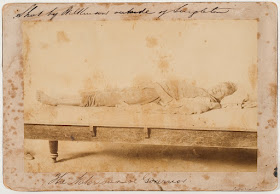Set in a rural landscape, with mountain views, Mudgee also boasts attractive heritage streetscapes and wide tree-lined streets.
The Wiradjuri People
Living around the Mudgee region for thousands of years, the Wiradjuri (people of the three rivers) of the Mowgee clan identify as River people with a deep connection to water.
Rivers were used by the Wiradjuri people for navigation and travel, for sourcing food and as boundaries between groups.
The name Mudgee (Moothi) means "nest in the hills" in the Wiradjuri language.
1850s: Gold Fever
1860s
The Cobb & Co Court is one of the oldest hotel buildings still standing in Mudgee. Built in the late 1850s, it was an overnight stop for the Cobb & Co Royal Mail Coaches.
The Mechanics Institute was built about 1861. George Henry Cox of "Burundulla", a son of Mudgee pioneer George Cox, was instrumental in the institute's establishment. The Encyclopedia Britannica and the Imperial Dictionary could be found in its well-stocked library. In the early 1880s, a two-storeyed verandah was added to the building.
The Mowgee women's totem is the wedgetail eagle (Mullian), and the men's totem is the crow (Waggan).
In Wiradjuri Dreamtime stories, Baiame is the creator god who came down from the sky to create rivers, mountains, and forests. He also gave the Aboriginal people their laws of life, traditions, songs, and culture. In traditional Aboriginal culture, women were not allowed to view depictions of Baiame nor visit scared Baiame sites.
The resin of the Black Cypress Pine trees (Callitris endlicheri) were used as medicine by the Wiradjuri, while River Sheoak (Casuarina cunninghamiana) produced a resin. Which was useful for repairs of boomerangs and other tools. Huts and shelters were often constructed from the bark of Black Box (Eucalyptus largiflorens). Read more
Wiradjuri life was governed by taboos and practices, arising from Dreamtime stories and traditional law. For example, avoidance relationships, including same-sex relationships, and the avoidance of eye contact as a form of respect, are common protocols.
Marriage was integral to many traditional Aboriginal groups, and polygyny was acceptable, although only men could have more than one wife. The age of marriage was mostly very different for men and women. A male would marry often in his early twenties, while the female was married at puberty.
The Hands on the Rock Aboriginal art site at Ulan is about 30 mins drive north of Mudgee and it can be reached after a 5-minute walk through the bush. The site has over 100 hand stencils and other motifs.
1800s
James Blackman, leading an small expedition in 1821, was the first explorer in the Mudgee district.
Blackman died at Mudgee in his slab hut built around 1837 on 6 May 1842.
The site of the town of Mudgee was surveyed in 1823. However, the village developed with the establishment of "Menah" run, with a police station and a lock-up by 1833. Binnawee Homestead, part of the original Menah run on the property, was built from 1850 to 1900.
In Wiradjuri Dreamtime stories, Baiame is the creator god who came down from the sky to create rivers, mountains, and forests. He also gave the Aboriginal people their laws of life, traditions, songs, and culture. In traditional Aboriginal culture, women were not allowed to view depictions of Baiame nor visit scared Baiame sites.
 |
| Aboriginal fire-making, using banksia cones or pieces of fungus for use as tinder or to carry fire from place to place, "Natives of Australia" (1906) |
Wiradjuri life was governed by taboos and practices, arising from Dreamtime stories and traditional law. For example, avoidance relationships, including same-sex relationships, and the avoidance of eye contact as a form of respect, are common protocols.
INTERESTING HUNTING METHODS
"An interesting feature of the Waradjuri tribe's hunting methods was the use of nets for capturing ducks. They would select the narrow neck of a billabong frequented by ducks for the spreading of the nets which would be stretched across the billabong at a little height above the water. Some of the natives equipped with a special kind of boomerang, which made a hissing noise when thrown through the air, would station themselves in hiding near the nets. Other natives would go higher up the billabong and frighten the ducks downstream. As they neared the nets the boomerangs would be thrown into the air and the birds, hearing the hissing noise of the weapons, thought they were being attacked by the duck hawk and immediately swooped low over the water and became entangled in the nets."
"An interesting feature of the Waradjuri tribe's hunting methods was the use of nets for capturing ducks. They would select the narrow neck of a billabong frequented by ducks for the spreading of the nets which would be stretched across the billabong at a little height above the water. Some of the natives equipped with a special kind of boomerang, which made a hissing noise when thrown through the air, would station themselves in hiding near the nets. Other natives would go higher up the billabong and frighten the ducks downstream. As they neared the nets the boomerangs would be thrown into the air and the birds, hearing the hissing noise of the weapons, thought they were being attacked by the duck hawk and immediately swooped low over the water and became entangled in the nets."
Daily Advertiser (Wagga Wagga, NSW : 1911 - 1954), Thursday 24 July 1941
Marriage was integral to many traditional Aboriginal groups, and polygyny was acceptable, although only men could have more than one wife. The age of marriage was mostly very different for men and women. A male would marry often in his early twenties, while the female was married at puberty.
A male's first wife may be an older widow, and the second wife, a female selected by infant betrothal (marriage did not take place until she reached puberty). Read more
The graves of notable Wiradjuri men were often marked with carved trees (dendroglyphs) to commemorate and as a form of artistic and spiritual expression.
Although more than 7500 Aboriginal-modified trees have been recorded in New South Wales, fewer than 100 of these carved trees remain in their original location.
In the 1850s, corroborees were still being reported on the hills surrounding Mudgee.The Hands on the Rock Aboriginal art site at Ulan is about 30 mins drive north of Mudgee and it can be reached after a 5-minute walk through the bush. The site has over 100 hand stencils and other motifs.
 |
| Hands on the Rock is an Aboriginal rock art site at Ulan in Central NSW |
 |
| Hands on the Rock is an Aboriginal rock art site at Ulan in Central NSW |
James Blackman, leading an small expedition in 1821, was the first explorer in the Mudgee district.
Blackman died at Mudgee in his slab hut built around 1837 on 6 May 1842.
Shortly afterwards, Lieutenant William Lawson, the commandant of Bathurst, made it to beyond Mudgee to the Talbragar River near Dunedoo on his second expedition into the region. He would become a large landholder in the region.
George and Henry Cox, the sons of William Cox, who built the first road over the Blue Mountains, became the first permanent European settlers on the Cudgegong River, establishing the "Menah" run, 3 km north-west of the present town. Menah meaning "flat country" in the Wiradjuri language.
1820s
George and Henry Cox, the sons of William Cox, who built the first road over the Blue Mountains, became the first permanent European settlers on the Cudgegong River, establishing the "Menah" run, 3 km north-west of the present town. Menah meaning "flat country" in the Wiradjuri language.
1820s
Wiradjuri woman, "Diana", was born at Mudgee in the 1820s, and it appears that she lived with the Cox family for a time. Living to the age of 78, Diana brought up eight children (or more), had three partners and gained ownership of more than 500 acres of land. Read more
1830s
In 1837, a period of significant bushranger activity, a police magistrate named Joshua Whiting was appointed to Mudgee. And a lock-up was constructed, overseen by William Blackman. The Mudgee district, which had more than 2000 inhabitants at the time, had only one magistrate, assisted by Wiradjuri trackers.
In 1838 Mudgee was proclaimed a town and town allotments were sold.
Large pastoral properties were established in the 1830s at Mudgee, such as the those held by the families, Lowe (Tinja), Rouse (Guntawang), Cox (Menah) and Bayley (Beau Desert).
In 1837, a period of significant bushranger activity, a police magistrate named Joshua Whiting was appointed to Mudgee. And a lock-up was constructed, overseen by William Blackman. The Mudgee district, which had more than 2000 inhabitants at the time, had only one magistrate, assisted by Wiradjuri trackers.
EARLY DAYS OF MUDGEE.
MUDGEE, Wednesday.—In the early days of Mudgee it was a common sight to see convicts getting 40 or 50 lashes. Old records at the local court show that for being out late at night, getting drunk, and other trivial offences, they received several lashes at the triangle.
The severest man in those days was a magistrate named Furlong, who died suddenly one night at the Grattan Hotel. Two convicts were sent from Mudgee to bring the body to town in a dray. Overjoyed at the death of Furlong, they decided to indulge in a spree, and became very merry.
On the return trip they selected the roughest parts of the road as a means of paying off old scores against their late enemy.
Northern Star (Lismore, NSW : 1876 - 1954), Thursday 26 July 1923
In 1838 Mudgee was proclaimed a town and town allotments were sold.
Large pastoral properties were established in the 1830s at Mudgee, such as the those held by the families, Lowe (Tinja), Rouse (Guntawang), Cox (Menah) and Bayley (Beau Desert).
1840s
Many roads, bridges, public buildings and churches were built by convict labour. Land was cleared through their efforts, crops grown, and convicts worked in mines, trades and domestic service. But this system "based on blood and torture" (DeTocqueville), came to an end in 1840, as anti-slavery and anti-transportation movements pushed for the humane treatment of the poor and those committing crimes.
A Court of Petty Sessions was established in Mudgee in 1840, and an early courthouse was located at the north-east corner of Court and Market Street.
By 1841, there were 36 buildings at Mudgee, mostly slab huts, three hotels, a hospital, a post office, two stores and the first Anglican church, St John's Church of England, which was consecrated on 6 May 1841 (a new building was erected in 1857 and the old church demolished in 1860).
Many roads, bridges, public buildings and churches were built by convict labour. Land was cleared through their efforts, crops grown, and convicts worked in mines, trades and domestic service. But this system "based on blood and torture" (DeTocqueville), came to an end in 1840, as anti-slavery and anti-transportation movements pushed for the humane treatment of the poor and those committing crimes.
A Court of Petty Sessions was established in Mudgee in 1840, and an early courthouse was located at the north-east corner of Court and Market Street.
By 1841, there were 36 buildings at Mudgee, mostly slab huts, three hotels, a hospital, a post office, two stores and the first Anglican church, St John's Church of England, which was consecrated on 6 May 1841 (a new building was erected in 1857 and the old church demolished in 1860).
 |
| New South Wales Government Gazette (Sydney, NSW : 1832 - 1900), Tuesday 28 January 1845 |
The population of Mudgee was only at 200 in 1851. And then, the gold rushes began.
Edward Hargraves found the first payable goldfields at Ophir, near Bathurst, on 12 February 1851, sparking the gold rush. Mudgee, an already established town adjacent to the goldfields, was soon to become an important service centre, and the population increased to 1500 by 1861.
While not many Aboriginal people worked as miners on the goldfields near Mudgee, and there are various reports of their reluctance to do so, they did provide help in building shelters for European miners. There are also reports of Aboriginal people selling items, such as a “boomerang”, for a couple of shillings.
The gold mining around Mudgee was both alluvial and quartz. Some of those diggings were Pipeclay, Budgee Budgee, Frome’s Creek and Rat’s Castle.
People flowed into Mudgee during those years of the gold rush between 1851 and 1880. In this period, a soap factory, a foundry, a flour mill, a cordial factory, a coach factory, as well as blacksmiths and wheelwrights, were established to serve the town and its visitors.
The pastoralists of Mudgee had to contend with drought, rain, fire and the lack of farm labour as the workers took off to try their luck at finding gold.
The gold mining around Mudgee was both alluvial and quartz. Some of those diggings were Pipeclay, Budgee Budgee, Frome’s Creek and Rat’s Castle.
People flowed into Mudgee during those years of the gold rush between 1851 and 1880. In this period, a soap factory, a foundry, a flour mill, a cordial factory, a coach factory, as well as blacksmiths and wheelwrights, were established to serve the town and its visitors.
The pastoralists of Mudgee had to contend with drought, rain, fire and the lack of farm labour as the workers took off to try their luck at finding gold.
New South Wales was granted self-government in 1856.
Wine & Grapes
Grapes were first grown in Mudgee in the 1850s by German immigrant, Adam Roth. Adam & Katherina Roth arrived in Australia from Germany on the Pauline. A year later, they planted Mudgee's first wine grapes and grew fruit and vegetables for the gold rush at their property, "Rothview" (later "Craigmoor").
Today Mudgee is one of Australia's most successful wine production areas.
The original Catholic Church was slab and bark. The Catholic presbytery was constructed in 1851, and in 1857, the Catholic Church was built.Grapes were first grown in Mudgee in the 1850s by German immigrant, Adam Roth. Adam & Katherina Roth arrived in Australia from Germany on the Pauline. A year later, they planted Mudgee's first wine grapes and grew fruit and vegetables for the gold rush at their property, "Rothview" (later "Craigmoor").
Today Mudgee is one of Australia's most successful wine production areas.
Cobb & Co.
The first coach service to Mudgee began in 1853. However, Cobb and Co did not begin operating from their Bathurst base until 1862.
The Cobb & Co Court is one of the oldest hotel buildings still standing in Mudgee. Built in the late 1850s, it was an overnight stop for the Cobb & Co Royal Mail Coaches.
 |
| Mudgee, NSW, Illustrated Sydney News (NSW : 1853 - 1872), Wednesday 16 November 1864 |
Mudgee’s original Methodist church was destroyed by fire and replaced in the 1860s.
The Mudgee Courthouse, built in 1862, is still in use as a court one of a few remaining public buildings designed by Colonial Architect Alexander Dawson.
Mudgee Gaol was a minor Police Gaol for short-term prisoners, which began operating in 1862, with William Reardon as the gaoler and his wife Margaret as the matron.
Mudgee Gaol was a minor Police Gaol for short-term prisoners, which began operating in 1862, with William Reardon as the gaoler and his wife Margaret as the matron.
Early postal services operated from a number of local stores and other premises until the telegraph office was built on the corner of Market and Perry Streets in 1862. The post office operated from the rear of this building until a separate post office was constructed in 1875.
James Christian Saddler
Arriving in Australia on the Isabella from County Wicklow, Ireland, James Christian moved to Mudgee in 1849 and established a business as a saddler and harness maker in Market Street, Mudgee.
James Christian was involved in many hotel businesses, as a proprietor and as sureties. In 1859, he was elected to the hospital board. And in 1860, he was elected as an alderman on Mudgee's first municipal council. The Christian family lived in Church Street.
Arriving in Australia on the Isabella from County Wicklow, Ireland, James Christian moved to Mudgee in 1849 and established a business as a saddler and harness maker in Market Street, Mudgee.
James Christian was involved in many hotel businesses, as a proprietor and as sureties. In 1859, he was elected to the hospital board. And in 1860, he was elected as an alderman on Mudgee's first municipal council. The Christian family lived in Church Street.
 |
| Home of James Christian and family in Church St, Mudgee, NSW |
 |
| James Christian's saddlery at Mudgee, NSW, |
 |
| Freeman's Journal (Sydney, NSW : 1850 - 1932), Saturday 23 September 1865 |
 |
| Corner Church & Market Streets, Mudgee, NSW about 1860s, James Christian's saddlery flat roof building |
Henry Lawson, was born at Grenfell in 1867, and was educated at Eurunderee and Mudgee. He lived around Mudgee from the age of six months to 15 years. And many of his stories were inspired by his memories of the area. It is also said that Henry Lawson spent many hours reading in the Mudgee Mechanic Institute’s library during his youth.
1870s
In late 1874, a 30-bed hospital was built at the cost of £3000 and designed by Sir Edmund Blacket.
 |
| Plan of Mudgee Hospital, NSW, Sydney Mail and New South Wales Advertiser (NSW : 1871 - 1912), Saturday 24 October 1874 |
In 1875 Mudgee had four steam flour mills and about twenty hotels and public-houses, the Royal, the Imperial, the Post Office, the Sydney, the Belmore, and the Club House and others. Also, two tanneries, a soap and candle manufactory and two coach factories.
Multicultural Bushrangers
Captain Thunderbolt and Mary Ann Bugg
Frederick Wordsworth Ward, better known as Captain Thunderbolt, was an Australian bushranger arrested in 1856 for selling 50 stolen horses.
Captain Thunderbolt and Mary Ann Bugg
Frederick Wordsworth Ward, better known as Captain Thunderbolt, was an Australian bushranger arrested in 1856 for selling 50 stolen horses.
Thunderbolt was sent to Cockatoo Island for 10 years, but he only served four. Given a ticket of leave, Thunderbolt was sent to work on a farm in Mudgee, where he met Mary Ann Bugg.
Mary Ann Bugg was educated at a girls' school in Sydney but found herself shunned by both Aboriginal and European people. Often dressing in men's clothes, Mary Ann was an expert horse rider and a skilled bush woman. She had an Aboriginal mother and a convict father.
Upon reaching the Mudgee police station, Thunderbolt was arrested for stealing the horse that he was riding and he was sent back to Cockatoo Island, to finish his six years in gaol, plus another three for the stolen horse. Thunderbolt would famously escape and become Known as the "gentleman bushranger".
 |
| Frederick Wordsworth Ward (1835 – 25 May 1870), better known by the pseudonym of Captain Thunderbolt |
Mary Ann met Thunderbolt in 1860 and they would eventually have three children together. She was his informer, scout and lover. It was Mary Ann who taught Thunderbolt to read.
Mary Ann became pregnant soon after meeting Thunderbolt, and Thunderbolt transported Mary Ann to her father's farm near Dungog. This act resulted in Thunderbolt not reporting to the Mudgee police on time, and his ticket of leave was cancelled.
Upon reaching the Mudgee police station, Thunderbolt was arrested for stealing the horse that he was riding and he was sent back to Cockatoo Island, to finish his six years in gaol, plus another three for the stolen horse. Thunderbolt would famously escape and become Known as the "gentleman bushranger".
 |
| Mary Ann Bugg was born in New South Wales, the daughter of a former convict called James Bugg and an Aboriginal woman called Charlotte |
Sam Poo
A Chinese miner named Sam Poo (nicknamed "Cranky Sam"), who was working on the goldfields near Mudgee, turned to highway robbery when prospecting was unsuccessful. He was also responsible for the rape of a settler's wife.
Sam Poo shot and killed a police constable, and when the troopers came after him, a gun battle ensued as he tried to avoid capture. Sam Poo was tried and hanged at Bathurst Gaol in 1865.
A Chinese miner named Sam Poo (nicknamed "Cranky Sam"), who was working on the goldfields near Mudgee, turned to highway robbery when prospecting was unsuccessful. He was also responsible for the rape of a settler's wife.
Sam Poo shot and killed a police constable, and when the troopers came after him, a gun battle ensued as he tried to avoid capture. Sam Poo was tried and hanged at Bathurst Gaol in 1865.
| Queenslander (Brisbane, Qld. : 1866 - 1939), Thursday 20 February 1936 |
Larry Cummins, Fred Lowry and John Foley
Cummins was gaoled for 15 years, but he escaped from Berrima Gaol and returned to bushranging. Later, he moved to Gippsland, where he used the name James Long. Under his new name, the former bushranger made whips and did some droving for a living. He died in 1909.
Jimmy and Joe Governor and Jack Underwood
Other notorious bushrangers of the region were Jimmy and Joe Governor and Jack Underwood, Aboriginal bushrangers who became known for the horrific Breelong Massacre. *Gender is the best predictor of criminal behaviour
The trio murdered Mrs Mawbey, Helen Kerz and three children: Grace and Percy Mawbey and their friend Elsie Clarke and then went on the run. The trio committed more than 80 crimes, including the rape of a 15-year-old girl at a farm at Cobark Creek. It's a complicated story. Read here (The Chant of Jimmie Blacksmith book and film are based on these events).
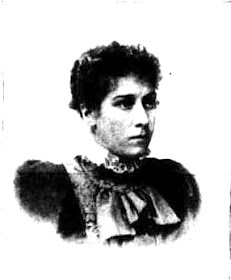 |
| Mrs Kerz, murdered at Breelong, Sydney Mail and New South Wales Advertiser (NSW : 1871 - 1912), Saturday 3 November 1900 |
 |
| Mrs Mawbey, murdered at Breelong, Sydney Mail and New South Wales Advertiser (NSW : 1871 - 1912), Saturday 3 November 1900 |
 |
| The arrival of Jacky Underwood, Sydney Mail and New South Wales Advertiser (NSW : 1871 - 1912), Saturday 3 November 1900 |
1880s
The grand Mudgee Railway Station shows the importance and wealth of Mudgee at the time when the station was built from 1883 to 1884. The station building was designed by engineer, John Whitton. However, passenger train services to Mudgee ceased in 1985.
By the 1880s, the gold rush in the region was pretty much over. And the people of Mudgee concentrated on pastoral and commercial enterprises. Mudgee also became a centre for grape growing and wine production.
Rolf Boldrewood
Rolf Boldrewood, the pseudonym of magistrate T A Browne, is most well known for his 1882 bushranging novel Robbery Under Arms, which is considered a classic of Australian colonial literature. He lived in a rented house at Guntawang near Mudgee.
Rolf Boldrewood, the pseudonym of magistrate T A Browne, is most well known for his 1882 bushranging novel Robbery Under Arms, which is considered a classic of Australian colonial literature. He lived in a rented house at Guntawang near Mudgee.
1890s
 |
| Mudgee railway Station, NSW, Australian Town and Country Journal (Sydney, NSW : 1870 - 1907), Saturday 24 October 1896 |
 |
| The School of Arts, Mudgee, NSW, Australian Town and Country Journal (Sydney, NSW : 1870 - 1907), Saturday 24 October 1896 |
 |
| The Mudgee Roller Flour Mill, Mudgee, NSW, Australian Town and Country Journal (Sydney, NSW : 1870 - 1907), Saturday 24 October 1896 |
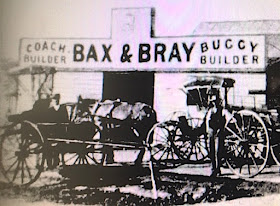 |
| Bax & Bray Buggy Builder, Mudgee, NSW, Australian Town and Country Journal (Sydney, NSW : 1870 - 1907), Saturday 24 October 1896 |
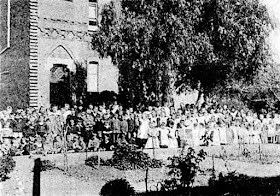 |
| St Matthew's Convent School, Mudgee, NSW, Freeman's Journal (Sydney, NSW : 1850 - 1932), Saturday 23 September 1899 |
 |
| Maurice Vale's drapery store, Freeman's Journal (Sydney, NSW : 1850 - 1932), Saturday 23 September 1899 |
 |
| Mr E. Deane's coach factory, Mudgee, NSW, Freeman's Journal (Sydney, NSW : 1850 - 1932), Saturday 23 September 1899 |
 |
| Western post and Mudgee newspaper, Freeman's Journal (Sydney, NSW : 1850 - 1932), Saturday 23 September 1899 |
 |
| G. D. Young's Federal Brewery, Mudgee, NSW, Freeman's Journal (Sydney, NSW : 1850 - 1932), Saturday 23 September 1899 |
1900s
 |
| Mudgee District Race Club, Mudgee, NSW, Sydney Mail and New South Wales Advertiser (NSW : 1871 - 1912), Saturday 30 November 1901 |
 |
| Mudgee Guardian and North-Western Representative (NSW : 1890 - 1954), Friday 13 April 1900 |
 |
| Committee, Mudgee District Race Club, Mudgee, NSW, Sydney Mail and New South Wales Advertiser (NSW : 1871 - 1912), Saturday 30 November 1901 |
 |
| M. J Cooney's Imperial Hotel, Mudgee, NSW, Sydney Mail and New South Wales Advertiser (NSW : 1871 - 1912), Wednesday 29 June 1904 |
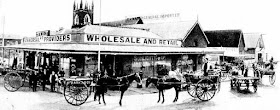 |
| T. H Marks and Co. Store, Can market and Church St, Mudgee, NSW, Sydney Mail and New South Wales Advertiser (NSW : 1871 - 1912), Wednesday 29 June 1904 |
 |
| Market St., Mudgee, NSW, Sydney Mail and New South Wales Advertiser (NSW : 1871 - 1912), Wednesday 29 June 1904 |
 |
| 1. Commercial Bank 2. Town Hall 3. Church of England, Market St, Mudgee, NSW, Sydney Mail and New South Wales Advertiser (NSW : 1871 - 1912), Wednesday 29 June 1904 |
 |
| Jas. Loneracan, Mudgee, NSW, Sydney Mail and New South Wales Advertiser (NSW : 1871 - 1912), Wednesday 29 June 1904 |
 |
| Auctioneer, H. E. A. Wells & Co. Mudgee, NSW, Sydney Mail and New South Wales Advertiser (NSW : 1871 - 1912), Wednesday 29 June 1904 |
 |
| Bank of New South Wales, Mudgee - 1905, Aussie~mobs |
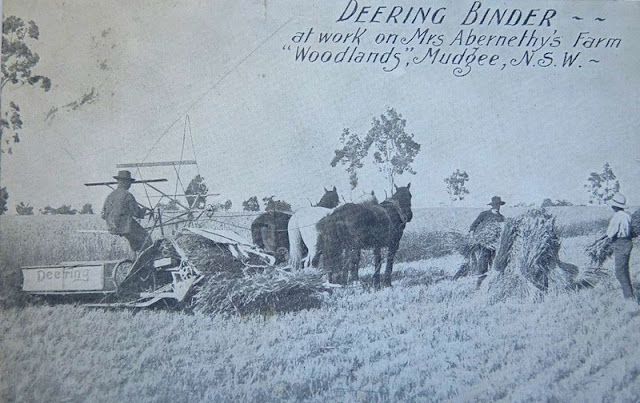 |
| DEERING BINDER at work on MRS. ABERNETHY'S FARM "WOODLANDS", MUDGEE, NSW - 1908, Kaye |
 |
| Mudgee Hospital, NSW, built 1874, (taken very early 1900s), Aussie~mobs |
 |
| Mudgee under snow. - Mudgee, NSW, c. 1905, possibly by Arthur Hardwick, State Library of New South Wales, Mudgee's heaviest snowfall on record was 56 centimetres (22 in) on 5 July 1900 |
 |
| Church Street, Mudgee, N.S.W. - circa 1907, Aussie~mobs |
 |
| H Hawkins and his buggy ponies, Sydney Mail and New South Wales Advertiser (NSW : 1871 - 1912), Wednesday 31 March 1909 |
 |
| The Cobb & Co Court right) is one of the oldest hotels buildings still standing in Mudgee, NSW. Built in the late 1850s, it was an overnight stop for the Cobb & Co Royal Mail Coaches |
WWI
Mudgee High School was established in 1916.
 |
| Mudgee High School built 1916, Daily Telegraph (Sydney, NSW : 1883 - 1930), Wednesday 17 May 1916 |
 |
| The 1916 Kookaburra recruitment march at Mudgee, NSW, Land (Sydney, NSW : 1911 - 1954), Friday 11 February 1916 |
 |
| The Mason brothers of Mudgee, NSW, Sydney Mail (NSW : 1912 - 1938), Wednesday 16 May 1917 |
 |
| Load of over 3,800 rabbits at Mudgee caught during 1918 plague, National Library of Australia |
1920s
 |
| Mudgee, NSW, circa 1921, SLNSW |
 |
| A woman holding a pineapple on a knife. She is standing in a pineapple plantation and is watched by two men and a woman. Mudgee District, New South Wales, Australia, circa 1920 |
 |
| Mudgee Guardian in the 1920, Mudgee, NSW, Mudgee Museum |
 |
| DESCENDANTS OF GEORGE AND HENRY COX grouped under the Camping Tree, "Menah" where the first settlers camped. Sydney Mail (NSW : 1912 - 1938), Wednesday 23 March 1921 |
 |
| Mudgee, NSW, circa 1920s, PD |
 |
| Sun (Sydney, NSW : 1910 - 1954), Wednesday 29 October 1924 |
 |
| Post Office, Mudgee, circa 1927, SLNSW |
The Mudgee Gaol closed in the 1920s and was demolished.
1930s
1930s
 |
| Market St, Mudgee, NSW, 1930s, PD |
 |
| Mudgee Show, Land (Sydney, NSW : 1911 - 1954), Wednesday 27 July 1938 |
 |
| Henry lawson, Catholic Freeman's Journal (Sydney, NSW : 1932 - 1942), Thursday 17 June 1937 |
|
 |
| Henry Lawson's home at Eurunderee, near Mudgee, circa 1948, SLNSW |
1940s and WWII
 |
| Mudgee Guardian and North-Western Representative (NSW : 1890 - 1954), Monday 26 February 1945 |
 |
| Mudgee Guardian and North-Western Representative (NSW : 1890 - 1954), Thursday 28 June 1945 |
1950s
The Hotel Mudgee which located on the south-eastern corner of Church and Mortimer Streets was demolished in 1965. The site is now occupied by a service station.
Around Mudgee
 |
| Polo match between Mudgee and Wellington, NSW, Newcastle Sun (NSW : 1918 - 1954), Thursday 12 June 1952 |
 |
| Mudgee, NSW, 1950s, Royal Society |
 |
| A Mobile Xray bus parked outside the Mudgee Town Hall, NSW, in the 1950s. Royal Society |
Around Mudgee
 |
| The original Court House Hotel (formerly the Mudgee Hotel) was demoted in 1965. This Court House Hotel was built about 1870 |
 |
| 45 Market St, Mudgee, NSW |
 |
| 62 Market St, Mudgee NSW built about 1920 for the State Bank of New South Wales |
 |
| Mudgee Railway Station, Mudgee, NSW, built from 1883 to 1884 |
 |
| Heritage building built in 1896 in Mudgee, NSW, was Eltons Pharmacy until 1992 |
 |
| Built in 1862, the Mudgee Mechanics' Institute, Mudgee, NSW |
 |
| The building of the Commercial Banking Company was built out of Mudgee brick in 1880, Mudgee, NSW |
 |
| Lawson Park Hotel, 1 Church Street, Mudgee, NSW, built 1860 |
 |
| Melrose park, built circa 1870, a Victorian homestead, Mudgee, NSW |
 |
| The old Catholic school Mudgee, NSW. Henry lawson attended this school for a short time |
 |
| Lawson Park Hotel was built in 1860, Mudgee, NSW |
 |
| Mudgee Town Hall was built in 1880 and served as the Town Hall until the 1970s, Mudgee, NSW |
 |
| The Cobb & Co Court (can right) is one of the oldest hotels buildings still standing in Mudgee. Built in the late 1850s |
 |
| “Mercer’s Pharmacy” 22 Church St, Mudgee, NSW |
 |
| St John-the-Baptist Anglican Church Mudgee, built 1881 |
 |
| Maitland Hotel (now the Woolpack Hotel), Mudgee, New South Wales |
 |
| The Regent Theatre at Mudgee, Church Street, Mudgee, in central west NSW was built in 1937 is an Art Deco style |
 |
| St Mary's Roman Catholic Church, Mudgee, NSW, built between 1873 and 1876 but incorporated parts of early church buildings |
 |
| Former Lester's Pharmacy, now Parkview Hotel, built about 1870, Mudgee, NSW |
 |
| The Mudgee Courthouse was built in 1862, Mudgee NSW, OZinOH |
Things To Do and Places To Go







